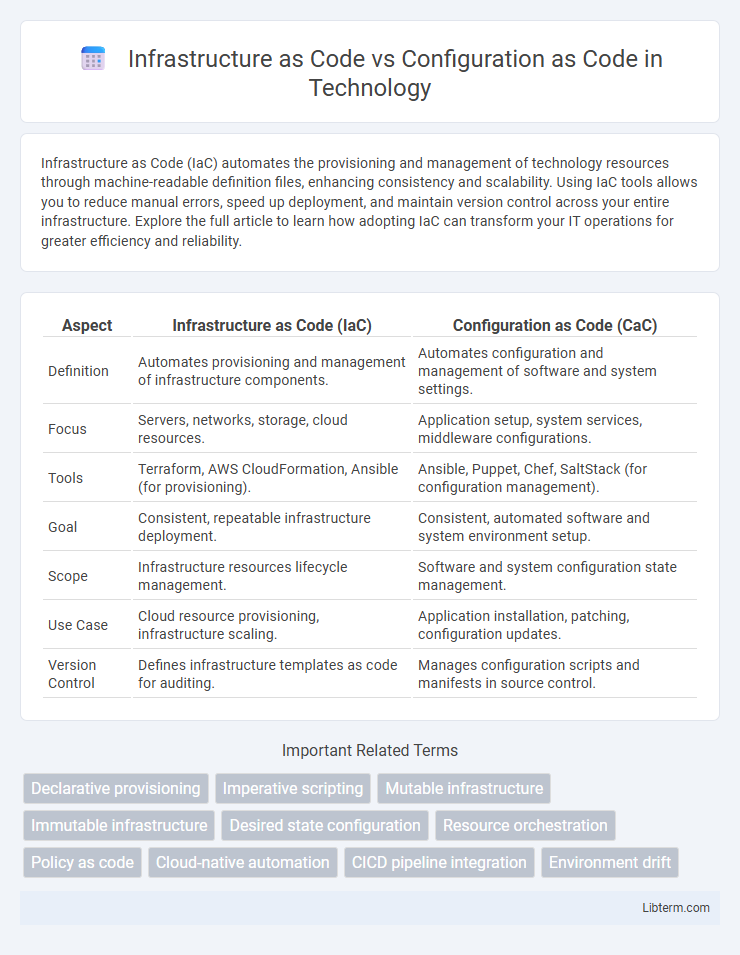Infrastructure as Code (IaC) automates the provisioning and management of technology resources through machine-readable definition files, enhancing consistency and scalability. Using IaC tools allows you to reduce manual errors, speed up deployment, and maintain version control across your entire infrastructure. Explore the full article to learn how adopting IaC can transform your IT operations for greater efficiency and reliability.
Table of Comparison
| Aspect | Infrastructure as Code (IaC) | Configuration as Code (CaC) |
|---|---|---|
| Definition | Automates provisioning and management of infrastructure components. | Automates configuration and management of software and system settings. |
| Focus | Servers, networks, storage, cloud resources. | Application setup, system services, middleware configurations. |
| Tools | Terraform, AWS CloudFormation, Ansible (for provisioning). | Ansible, Puppet, Chef, SaltStack (for configuration management). |
| Goal | Consistent, repeatable infrastructure deployment. | Consistent, automated software and system environment setup. |
| Scope | Infrastructure resources lifecycle management. | Software and system configuration state management. |
| Use Case | Cloud resource provisioning, infrastructure scaling. | Application installation, patching, configuration updates. |
| Version Control | Defines infrastructure templates as code for auditing. | Manages configuration scripts and manifests in source control. |
Understanding Infrastructure as Code (IaC)
Infrastructure as Code (IaC) involves managing and provisioning computing infrastructure through machine-readable definition files, enabling automated, consistent, and scalable deployment of resources. IaC uses declarative languages like Terraform or CloudFormation to define infrastructure components such as servers, networks, and storage, promoting version control and reducing manual intervention. Understanding IaC enhances DevOps practices by streamlining infrastructure management, improving repeatability, and accelerating deployment cycles.
What is Configuration as Code (CaC)?
Configuration as Code (CaC) refers to the practice of managing and automating the setup of software environments using machine-readable configuration files, enabling consistent and repeatable deployments. CaC focuses specifically on defining system configurations, such as application settings, environment variables, and runtime parameters, ensuring infrastructure components are consistently configured across development, testing, and production stages. Unlike Infrastructure as Code (IaC), which provisions and manages underlying infrastructure resources, CaC targets the detailed configuration and state management of software systems within those infrastructures.
Key Differences Between IaC and CaC
Infrastructure as Code (IaC) defines and manages the entire infrastructure setup, including servers, networks, and storage, using machine-readable configuration files, enabling automated provisioning and scaling. Configuration as Code (CaC) specifically handles the configuration and management of software and applications running on the infrastructure, focusing on settings, dependencies, and environment variables to ensure consistent application deployment. IaC targets infrastructure lifecycle management, while CaC concentrates on application and software environment consistency within that infrastructure.
Benefits of Implementing Infrastructure as Code
Implementing Infrastructure as Code (IaC) streamlines environment provisioning, enabling fast and repeatable deployments that drastically reduce manual errors compared to traditional Configuration as Code (CaC) approaches. IaC facilitates automated infrastructure management using declarative templates, improving scalability and consistency across development, testing, and production stages. Enhanced version control and collaboration through IaC tools like Terraform or AWS CloudFormation ensure traceability and easy rollback, accelerating DevOps workflows and driving operational efficiency.
Advantages of Using Configuration as Code
Configuration as Code streamlines system management by enabling consistent, repeatable environment setups, reducing human error and deployment time. It enhances collaboration through version-controlled configuration files, facilitating easier audits and rollback capabilities. This approach improves scalability by allowing rapid configuration changes and automated updates across multiple servers or applications.
Common Tools for IaC and CaC
Terraform and AWS CloudFormation are prominent tools for Infrastructure as Code, enabling automated provisioning and management of cloud resources through declarative scripts. Ansible, Chef, and Puppet are widely used for Configuration as Code, focusing on automating software installation, system configurations, and ongoing management across servers. Both IaC and CaC tools integrate with CI/CD pipelines to enhance consistency, scalability, and version control in cloud infrastructure and system configurations.
Use Cases: When to Use IaC vs CaC
Infrastructure as Code (IaC) is ideal for managing and provisioning cloud resources like virtual machines, networks, and storage, enabling automated, repeatable infrastructure setups in environments such as AWS, Azure, and Google Cloud. Configuration as Code (CaC) excels in managing application settings, software packages, and system configurations on existing infrastructure, ensuring consistent environments through tools like Ansible, Chef, and Puppet. Use IaC when designing and deploying entire infrastructure stacks, while CaC applies best to maintaining and updating application and system configurations within that infrastructure.
Security Considerations in IaC and CaC
Infrastructure as Code (IaC) and Configuration as Code (CaC) both automate IT environments but differ in scope, with IaC managing entire infrastructure and CaC focusing on software and system configurations. Security considerations in IaC include managing sensitive data such as API keys and credentials within code repositories using encryption and secure storage solutions like HashiCorp Vault. CaC security emphasizes enforcing configuration compliance, minimizing attack surfaces through hardened system settings, and continuous monitoring to detect unauthorized changes.
Best Practices for Managing IaC and CaC
Effective management of Infrastructure as Code (IaC) and Configuration as Code (CaC) requires adopting best practices such as version control, modularization, and automated testing. Utilizing tools like Terraform for IaC and Ansible for CaC ensures consistent environment provisioning and configuration management across development, staging, and production. Implementing continuous integration/continuous deployment (CI/CD) pipelines enhances code quality and minimizes errors, promoting reproducibility and infrastructure reliability.
Future Trends in Infrastructure and Configuration Automation
Infrastructure as Code (IaC) automates the provisioning and management of physical and virtual resources, while Configuration as Code (CaC) focuses on ensuring software environments and system settings are consistently configured. Future trends highlight the rise of AI-driven automation, enabling predictive infrastructure scaling and self-healing configurations that reduce manual intervention. Integration of IaC and CaC with container orchestration platforms like Kubernetes will accelerate deployment velocity and enhance system resilience.
Infrastructure as Code Infographic

 libterm.com
libterm.com